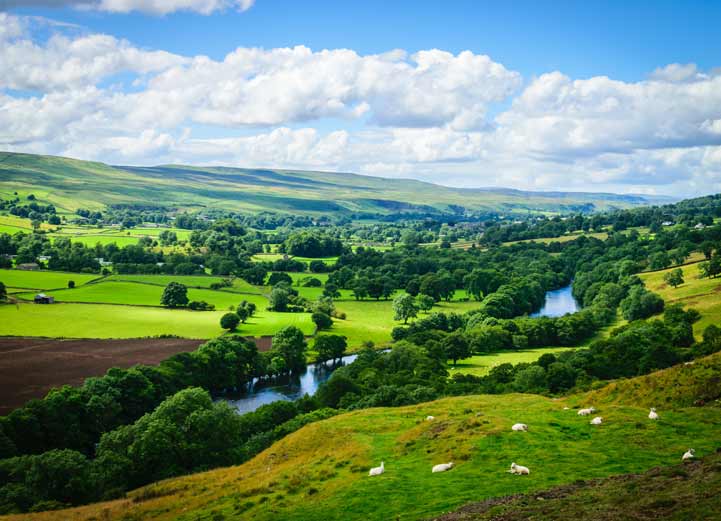The UK’s farmland market has a history of long-term stable returns, but what are the reasons for this and how do these compare in a global context?
As a globally mature farmland market, the UK boasts a successful history of long-term stable returns. Strong property laws, financial security and plentiful diversification opportunities across energy, infrastructure and tourism have enabled this to continue. However, as competition for land use brings the disconnect between value and earning potential from farmland alone back into focus, it is worth standing back to consider UK farmland investments in a global context.

Political security
Despite all the noise and uncertainty generated from the UK political scene of late, the strength of its developed democracy has not wavered. Political leaders and customs unions may come and go, but the UK, with its robust constitution and court system, continues to be valued by investors.
In the six years following the Global Financial Crisis (GFC), average UK farmland values appreciated 76% in nominal terms (9.9% Compound annual growth rate).
The simple appeal of a tangible asset with secure and transparent ownership laws drove investment following a period of great uncertainty
Savills Rural Research
While there were a number of factors at play, the simple appeal of a tangible asset with secure and transparent ownership laws drove investment following a period of great uncertainty. This is a scenario not many countries around the world can offer.
Take Argentina for example; a world leader in agricultural production and a nation rich in natural resources, yet historically poor at attracting and developing any type of inward investment.
Argentina struggles to manage the risks of a volatile macroeconomic environment, policy instability and an underdeveloped financial sector, making the investment case a particularly hard sell. For those game and with appetite, the risk-reward balance holds true. However, with no land title insurance system and an erratic political climate, the grass would seem greener elsewhere.
Financial stability
Financial stability is not the same as market stability and for real estate investments it is important to make that distinction. Materially, the economic risks of Brexit-related market disruption remain, but investors should be comforted by the fact that major UK financial institutions are prepared. Under guidance from the Prudential Regulation Authority (PRA), major banks now hold up to three times the Tier 1 capital coverage they had prior to the GFC (see graph below). Furthermore, stress test modelling by the Bank of England suggests that in the event of another severe recession (or one worse than the GFC), banks would still hold more capital after the event, compared to the coffers before the global market shock of 2008.
From a global context, while lending reform and regulation has been a focus over the last decade, there are regions and sectors where this has been harder to achieve. Romania is one of Europe’s leading emerging markets, yet 12 years following its official entry into the EU, it ranks as the lowest EU state for access and usage of funds from banks and lending institutions. Some 90% of agricultural holdings struggle to find credit at competitive rates, despite an 8% annualised growth farmland prices over the past decade. Signs are improving with agricultural debt up 180% since 2015 and non-performing loan ratios decreasing, but with 40% of agricultural land directly foreign owned, opportunity to control the balance sheet may well be lost.
In comparison, UK lenders are competing for opportunities to leverage their loan books against farmland, particularly as natural capital reserves show potential to consolidate in monetary and social value. This developing value proposition is a unique string to the bow of the rural sector and it’s clear the government intends to drive it.
Foreign ownership
Regulation of foreign investment is a careful balance of protectionism and national security with economic growth and prosperity. With farmland, it is no different as issues of food and resource security add further layers of complexity.
Barriers to entry for foreign buyers in the UK remain low, with the only notable impediment being a 3% stamp duty surcharge on residential property. Overseas buyers of land in the UK also do not receive the inheritance tax breaks that benefit UK citizens, but by and large, the market is free, competitive and transparent.
In comparison, countries such as Australia and New Zealand subject varying levels of foreign investment to government approval. Australia’s Foreign Investment Review Board judge proposals to buy farmland on a range of criteria, with the purchaser required to pass a national interest test and prove a transparent sale process. Similarly, New Zealand’s Overseas Investment Office determines whether applications for foreign ownership of sensitive assets satisfy beneficial national interest conditions and add significant long-term value to the sector and economy. The criteria are regularly under review, often leaving landowners and investors to question exit positions should investment capital be constrained.
For all of the internal discontent and frustration at delayed policy intervention, the global attractiveness of UK rural property remains a core driver of demand. While neighbours can often compete aggressively for once-in-a-lifetime land sales, pushing up prices, potential sellers can look a little further than over the hedge when planning a land sale. The market for UK farmland remains a global one.
Read the articles within Spotlight: The Farmland Market below.
.jpg)

